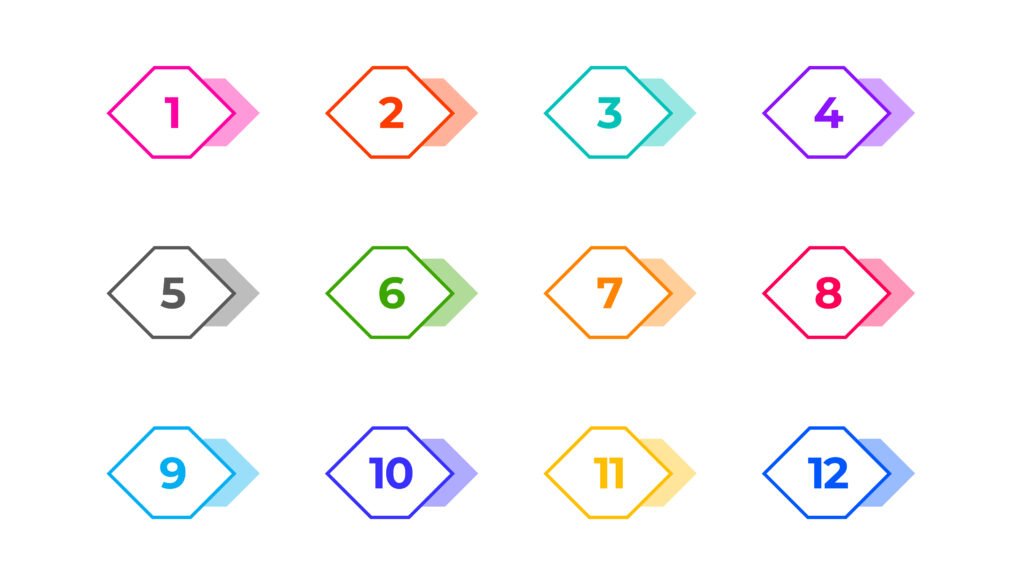What are consecutive numbers?

The consecutive numbers are like a team of numbers that stand next to each other with no gaps in between. Imagine they are all in a single line, one after the other. Each number has a friend just before it and another right after it. The one before is called a “predecessor” and the one after is the “successor”. For example, in the team of numbers 1, 2, 3, 4, and 5, 2’s friend before it is 1, and the friend after is 3.
Understanding consecutive numbers is important because they show up in lots of maths problems and real-life situations. Hence, this helps us make meaning of things that follow a smooth and ordered pattern.
In this context, we will cover a few different types of consecutive numbers. First, there are the regular ones, like 1, 2, 3, and so on. We will also talk about consecutive numbers with bigger steps between them, like 80, 82, 84, and so on. These are called “consecutive even integers”. Then, there are consecutive numbers that go down and even include negative numbers, like -1, 0, 1, and more. So, let’s understand the world of consecutive numbers and see how they make math and real life more understandable.
Understanding Consecutive Numbers
Consecutive numbers are a sequence of integers where each number follows the previous one with a consistent difference, typically 1. For example, if the first number is ‘n,’ the consecutive numbers in the series are ‘n, n + 1, n + 2, n + 3,’ and so on.
This constant difference between adjacent numbers creates a straightforward and predictable pattern. Consecutive numbers are essential in mathematics, helping solve equations and understand number sequences.
How do you find consecutive numbers?
To find consecutive numbers, begin with an initial value, which is generally called the first term. Then, apply a constant difference to generate the succeeding numbers in the sequence. For positive consecutive numbers, this difference is usually 1. You start with the first term and add 1 to it to get the next number, and continue this process for as many consecutive numbers as needed.
For negative consecutive numbers, you follow a similar pattern but instead, subtract 1 from the first term to get the following numbers. This generates a sequence of decreasing negative integers.
If you are interested in generating consecutive even or odd numbers, you can still use the concept of a common difference. For consecutive even numbers, you start with an even number and add 2 to each successive number. To find consecutive odd numbers, begin with an odd number and add 2 to each subsequent number. This approach creates sequences of even or odd integers that follow one another in a straightforward and unbroken order.
How do you calculate consecutive numbers?
To calculate consecutive numbers, you start with a given number, often referred to as the first term, and then add a fixed constant, known as the common difference, to obtain the next number in the sequence. For positive consecutive numbers, you add 1 to each previous number, ensuring a consistent increment of 1 between each term. For negative consecutive numbers, you subtract 1 from each previous number. This creates a straightforward and predictable pattern. You can also use mathematical formulas to find consecutive numbers more efficiently, where the nth term can be represented as ‘n,’ and for negative consecutive numbers, it’s ‘-n,’ simplifying problem-solving involving consecutive numbers.
The formula for Adding consecutive numbers
The sum of consecutive numbers can be calculated using the formula: Sum = (n/2) * [2a + (n-1)d].
Where:
- ‘n’ represents the number of terms.
- ‘a’ is the first term.
- ‘d’ is the common difference between the terms.
For example, the sum of the first 5 positive consecutive numbers (1, 2, 3, 4, 5) would be (5/2) * [2 * 1 + (5-1) * 1] = 15.
Consecutive numbers example
Here’s a brief example of consecutive numbers:
Consider the series of positive consecutive integers starting from 10: 10, 11, 12, 13, 14, and so on. These numbers follow one another with a constant increment of 1. Similarly, negative consecutive integers could be represented as -5, -4, -3, -2, -1, each being one less than the previous number. In both cases, the common difference between adjacent terms is 1. These examples explain the concept of consecutive numbers and how they form an unbroken sequence with a predictable pattern, which is fundamental in mathematics and practical for various applications and calculations.
Properties of Consecutive Numbers
Properties of consecutive numbers are built-in characteristics and relationships that rule their behaviour. These properties help in understanding and manipulating consecutive numbers in various mathematical contexts.
- Constant Difference: Consecutive numbers indicate a fixed difference between any two successive numbers. In a sequence starting with ‘n,’ the next numbers are ‘n + 1,’ ‘n + 2,’ ‘n + 3,’ and so on. This consistent increment by 1 creates a predictable pattern, helping in calculations and analysis.
- Even and Odd Differences: Consecutive odd numbers have a constant difference of 2. For example, in the sequence 3, 5, 7, and 9, the difference between any two consecutive odd numbers is 2. Similarly, consecutive even numbers also have a fixed difference of 2, as seen in sequences 12, 14, 16, 18.
- Sum Divisibility: The sum of ‘n’ consecutive numbers is divisible by ‘n’ if ‘n’ is an odd number. For instance, in a sequence of seven consecutive odd numbers, the sum is divisible by 7. This property is particularly useful in mathematical proofs and number theory.
- Odd Sum: The sum of two consecutive numbers is always an odd number. For example, in the sequence 1, 2, 3, 4, 5, the sum of any two consecutive numbers is an odd number (1 + 2 = 3, 2 + 3 = 5).
- Even Sum: The sum of two consecutive odd numbers is always an even number. For example, in the sequence 5, 7, 9, 11, the sum of any two consecutive odd numbers is even (5 + 7 = 12, 7 + 9 = 16).
- Even Sum (Even Numbers): The sum of two consecutive even numbers is always an even number. For example, in the sequence 12, 14, 16, the sum of any two consecutive even numbers is even (12 + 14 = 26, 14 + 16 = 30).
Applications of Consecutive Numbers
- Number Patterns: Consecutive numbers help identify and understand patterns in sequences and series.
- Algebraic Equations: They play an important role in solving equations, especially in linear equations.
- Statistics: Consecutive data points are essential for calculating means, medians, and other statistical measures.
- Real-World Scenarios: Consecutive numbers are used in various fields, such as finance, physics, and computer science, to model and analyze continuous processes.
Conclusion
In conclusion, understanding the concept of consecutive numbers is essential in mathematics. Consecutive numbers are a sequence of integers where each number follows the previous one by a fixed difference of 1. These numbers are commonly discovered in various mathematical problems, including arithmetic sequences, number patterns, and series. Knowledge of this basic concept serves as a building block for more advanced mathematical topics and problem-solving. Just as it is important for children to learn road safety rules to navigate the complexities of today’s traffic, learning the concept of consecutive numbers is important for a strong foundation in mathematics, enabling students to overcome more complex mathematical challenges with confidence and skill.
For more insights on enhancing your child’s learning experience and to explore our educational philosophy, visit Chrysalis High.
FAQ’s
1. What is the HCF of two consecutive even numbers?
The HCF of two consecutive even numbers is always 2, as both numbers are divisible by 2.
2. What is the HCF of two consecutive odd numbers?
The HCF of two consecutive odd numbers is 1, as there are no common factors other than 1 between consecutive odd numbers.
3. What is the sum of two consecutive even numbers?
The sum of two consecutive even numbers can be found by using the formula for the sum of consecutive numbers noted earlier. It would be the average of the two numbers, which is their midpoint. For example, the sum of 8 and 10 is (8 + 10) / 2 = 9.


